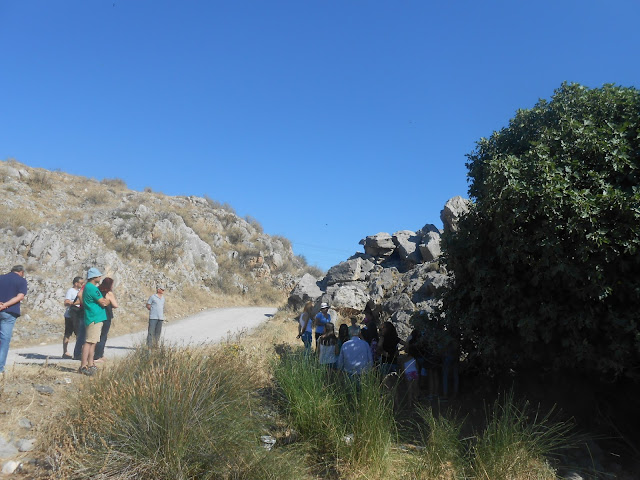Διονύσια 2016 - Τεγύρα / Σχεδιάζω τη χαμένη πόλη: Η επιλογή των 6.
Σάββατο 16 Ιουλίου 2016.
ΕΥΧΕΤΗΡΙΕΣ ΚΑΡΤΕΣ στα ΑΡΧΑΙΑ ΕΛΛΗΝΙΚΑ
προς την χαμένη πόλη ΤΕΓΥΡΑ
με θέμα το κτιριολογικό πρόγραμμα μιας ελληνικής πόλης από τον 5ο αι. έως τον 1ο αι. π.Χ., διάστημα το οποίο οι Έλληνες κόσμησαν τον δημόσιο χώρο με περίτεχνα οικοδομήματα από τα οποία επιλέχθηκαν έξι (6) …
1 - Ο Nαός του Απόλλωνα, Δελφοί (4ος αι.).
2 - Η θόλος, Δελφοί (4ος αι.).
3 - Το βουλευτήριο, Μίλητος (2ος αι.).
4 - Η στοά του Αττάλου ΙΙ, Αθήνα (2ος αι.).
5 - Το θέατρο, Επίδαυρος (4ος αι.).
6 - Το Παναθηναϊκό στάδιο, Αθήνα (4ος αι.).
9.00 - 11.00 π.μ.
Επίσκεψη στον Διόνυσο Βοιωτίας και την γύρω περιοχή
με την
αρχαιολόγο Πηνελόπη Κουρκούτη.
11.00 - 13.00 μ.μ
Κατασκευές με χαρτόνι, σε αίθουσα του Δημοτικού Σχολείου Διονύσου,
με την
αρχιτέκτονα Μάρω Ρόδη.
Σε συνεργασία με τον Eπιμορφωτικό Σύλλογο Διονύσου
και την κα. Κική Καραβαγγέλη, Δημοτική Σύμβουλο του Δήμου
Ορχομενού.
Ένα μεγάλο ΕΥΧΑΡΙΣΤΩ στον Επιμορφωτικό Σύλλογο Διονύσου και την κα. Κική Καραβαγγέλη για τον συντονισμό της δράσης και τον Γιάννη Βελαώρα για την υπέροχη φιλοξενία στον Διόνυσο, τα παιδιά και τους ενήλικες που συμμετείχαν στην δράση. Καλή συνέχεια στα Διονύσια 2016 και Καλό Καλοκαίρι!
Introduction
In the archaic and classical periods, ancient Greek society expressed itself in architecture with temples and public buildings but private residences remained humble and inconspicuous. At the end of the 5th century. B.C. public works in cities have a common typology and Greeks are starting to pay more attention to where they live.
TEMPLE THOLOS BOULEUTERION STOA THEATRE STADIUM
Dionysia 2016 - Tegyra / I design the lost ancient Greek city: The choice of 6.
Saturday 16 July 2016.
GREETING CARDS in ANCIENT GREEK
to the lost city of TEGYRA/ next to modern village of Dionysus*, Viotia, Region of Central Greece.
with a theme based on the building program of a Greek city of the 5th century to the 1st century B.C., a period which the Greeks adorned public space with ornate buildings of which six (6) were selected ...
1 - The Temple of Apollo, Delphi (4th c.).
2 - The Dome (Tholos), Delphi (4th c.).
3 - The Parliament (Bouleuterion), Miletus (2nd c.).
4 - The Stoa of Attalos II, Athens (2nd c.).
5 - The Theatre, Epidaurus (4th c.).
6 - The Panathenaic stadium, Athens (4th c.).
9:00 - 11:00 a.m.
Visit to Dionysus and the surrounding area with Penelope Kourkouti, archaeologist.
11.00 - 13.00 pm
Greeting Cards with cardboard in the Primary School of Dionysus with Maro Rodi, architect.
In cooperation with Educational Association of Dionysus, Viotia, Greece and Ms. Kiki Karavaggeli, Municipal Counsellor of Municipality of Orchomenos, Region of Central Greece.
Thank you for the positive energy and active participation!
* Dionysus (Greek: Διόνυσος) is the god of the grape harvest, winemaking and wine, of ritual madness, fertility, theatre and religious ecstasy in Greek mythology.


In the vestibule of the Temple of Apollo at Delphi are written two maxims well known as Delphic Maxims, KNOW THYSELF and NOTHING IN EXCESS, on either side of the holy letter E.
These two (2) axioms, along with 145 others, altogether 147, as cultural heritage is handed by the seven (7) wise * Greek men of antiquity to future generations.
Out of the 145, a choice was made of six (6).
1 - Worship the Gods
2 - Obey the law
3 - Act when you know
4 - Use time sparingly
5 - Perceive what you have heard
6 - Cling to discipline
* (Thales of Miletus, Pittacus of Mytilene, Bias of Priene, Solon the Athenian, Cleobulus of Rhodes, Periander of Corinth, Chilon of Sparta).








Greeting Cards in ancient Greek with cardboard in the Primary School of Dionysus with Maro Rodi, architect.


Visit to Dionysus and the surrounding area with Penelope Kourkouti, archaeologist.




Ο Διόνυσος είναι
πεδινό χωριό βόρεια της πεδιάδας της Κωπαΐδας και του ομώνυμου Δημοτικού
διαμερίσματος του Δήμου Ορχομενού στο νομό Βοιωτίας, Περιφέρεια Στερεάς
Ελλάδας.
Ο οικισμός Τσαμάλι ή
Τζαμάλι ή Τζαμάλιον εμφανίζεται επίσημα για πρώτη φορά να ανήκει στο Δήμο
Ορχομενού στο τέλος του 19ου αιώνα. Ιδρύθηκε και κατοικείται από Σαρακατσάνους
(Ελληνική φυλή νομάδων κτηνοτρόφων), οι οποίοι για πολλά χρόνια ξεχειμώνιαζαν
σ΄αυτόν εδώ τον τόπο, μέχρι να ΄ρθει η άνοιξη και να ξαναπάρουν το δρόμο για τα
ορεινά βοσκοτόπια τους (Άγραφα, Καλλίδρομο, Όλυμπο, Οίτη, Όθρυ). Όταν σιγά σιγά
άρχισαν να ασχολούνται με την γεωργία, εγκαταστάθηκαν μόνιμα, και δημιούργησαν
έναν σύγχρονο οικισμό.
Το Τσαμάλι
μετονομάστηκε το 1955 σε Διόνυσο επειδή οι κάτοικοι του, θεώρησαν ότι τα απομεινάρια
των βάθρων των αγαλμάτων που βρέθηκαν νότια του οικισμού, σκαλισμένα στους
πρόποδες του βράχου, ανήκαν σε ναό του Διονύσου. Σήμερα έχει αποδειχθεί ότι ο
ναός ήταν αφιερωμένος στον Ηρακλή.
Πέντε (5) χιλιόμετρα δυτικά από το χωριό στην περιοχή Καμπιά,
βρίσκεται η Μονή του Οσίου Μάρτυρα Νικολάου του Νέου, που χρονολογείται στις
αρχές του 11ου αιώνα και θεωρείται σύγχρονη αυτής του Οσίου Λουκά.
Κοντά στον Διόνυσο βρισκόταν η αρχαία Βοιωτική πόλη Τεγύρα.
Η Τεγύρα, (ή Τεγύρες, αρχ. αι Τεγύραι), ήταν αρχαία πόλη των
Βοιωτών, στα όρια της αρχαίας Βοιωτίας με την αρχαία Φωκίδα, 5 χλμ. βόρεια του
Ορχομενού, στη θέση "Πολυγύρα", κοντά στο σημερινό χωριό Διόνυσος.
Σύμφωνα με τον Πλούταρχο, στην πόλη λειτουργούσε, στο ναό
του Απόλλωνα τον επονομαζόμενο Τεγυραίο, το φημισμένο Τεγυραίο μαντείο μέχρι τα
χρόνια των Περσικών πολέμων και του Πελοποννησιακού πολέμου και μόνο ύστερα απ'
αυτούς έμεινε άφωνο.
Από τη λέξη Πόλις προέρχονται ετυμολογικά οι λέξεις Πολιτική
και Πολιτισμός.
Πόλεις οργανωμένες υπήρξαν σε πολύ παλαιότερες περιόδους από εκείνες που διεκδικεί η ελληνική ιστορία με ζωντανή και δυναμική μυθολογία και θεωρούνταν από τους λαούς που τις κατοίκησαν κυριολεκτικά και μεταφορικά άξονας του κόσμου (axis mundi).
Η διαφορά βρίσκεται στο γεγονός ότι έστω και με τα σαφή πολιτικά και κοινωνικά τους μειονεκτήματα - θεωρούμενα από την οπτική γωνία του παρόντος χρόνου - οι ελληνικές πόλεις στις καλύτερες στιγμές τους κληροδότησαν στο σύγχρονο πολιτισμό ιδέες όπως…
η ανοχή στην ιδιαιτερότητα, το ζωντανό ενδιαφέρον για την πορεία της κοινότητας και το πάθος για την ανεξαρτησία.
Καλή συνέχεια!

Dionysus is a village north of the plain Copais part of Municipality of Orchomenos in Viotia, Region of Central Greece.
The settlement Tsamali or Jamal or Tzamalion official first appears to belong to the Municipality of Orchomenos in the late 19th century. Founded and inhabited by Sarakatsans (Greek race pastoralists), who for many years wintered here until spring only then to retake the road to the mountain pastures (Blank, Kallidromo, Olympus, Iti, Othris). When gradually began to engage in agriculture, they settled permanently, and created a modern settlement here.
The Tsamali renamed in 1955 to Dionysus* because residents considered that the remnants of the pedestals of statues found south of the village, carved at the foot of the rock, belonged to a temple of Dionysus. Today has shown that the church was dedicated to Hercules.
Five (5) kilometers west of the village in Kambia district, is the Monastery of St. Nicholas the New Martyr, dating back to the early 11th century and is considered modern that of Hosios Loukas of Stiris Monastery (UNESCO World Heritage Site).
Near Dionysus was the ancient city Tegyra.
The Tegyra (Tegyra, anc. Tegyrai century), was an ancient city of Viotia, the limits of ancient Boeotia with ancient Phocis, 5 km. North of Orchomenos, to "Polygyros", near the village of Dionysus.
According to Plutarch, the city functioned the temple of Apollo called the Tegyraio, the famous oracle Tegyraio until the reign of the Persian Wars and the Peloponnesian war and only after them remained speechless.
From Polis (= city) word are etymologically derived words like Politics and Culture.
Organized cities were in much earlier times than those claimed by ancient Greeks with lively and dynamic mythology being considered by the people who literally lived there as axis of the world (axis mundi).
The difference lies in the fact that even with clear political and social disadvantages - considered from the perspective of the present time - the Greek cities in their best moments bequeathed to modern civilization ideas as tolerance towards individuality, lively interest in the course of community and passion for independence.
To the future of cities - Enjoy your summer in Greece!






















Δεν υπάρχουν σχόλια:
Δημοσίευση σχολίου